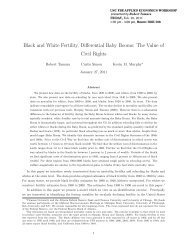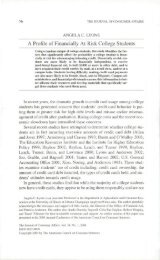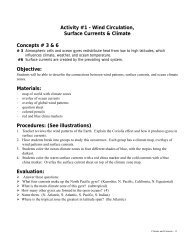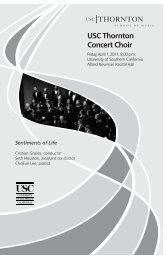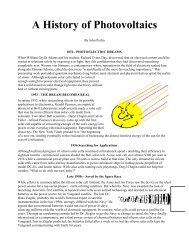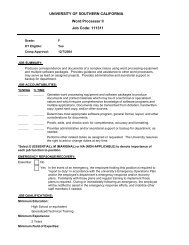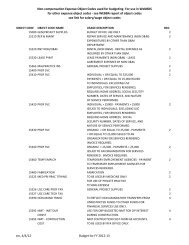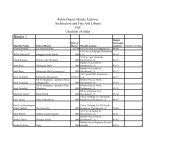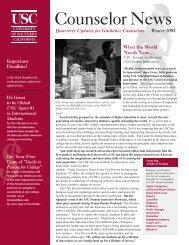15. RS 1.003 (RaJsu-yeni - nql?) RS 18.056 (RaJsu-yeni -5'[ ... ])
15. RS 1.003 (RaJsu-yeni - nql?) RS 18.056 (RaJsu-yeni -5'[ ... ])
15. RS 1.003 (RaJsu-yeni - nql?) RS 18.056 (RaJsu-yeni -5'[ ... ])
Create successful ePaper yourself
Turn your PDF publications into a flip-book with our unique Google optimized e-Paper software.
<strong>15.</strong> <strong>RS</strong> <strong>1.003</strong> (<strong>RaJsu</strong>-<strong>yeni</strong> - <strong>nql</strong>?)<strong>RS</strong> <strong>18.056</strong> (<strong>RaJsu</strong>-<strong>yeni</strong> -<strong>5'</strong>[ ... ])These two texts provide the most extensive examples of overlappingtexts known in Ugaritic, let alone in the ritual texts: <strong>RS</strong> <strong>1.003</strong>:1-49 and<strong>RS</strong> <strong>18.056</strong>:1-53 are, as nearly as can be determined from their damagedstate, virtual duplicates. (In addition, <strong>RS</strong> <strong>1.003</strong>:12-191<strong>RS</strong> <strong>18.056</strong>:13-21duplicate, with some variants, a portion of the rite for a day and a nighttranslated below as text 17 [<strong>RS</strong> 1.001:3-10). Because, however, each textends differently, I believe that they were prepared independently in orderto reflect two different situations in the year. If the only month name thatis preserved, Ra)su-Yeni, "the first wine," is indeed the last month of thelunar calendar, it is plausible to deduce that the two texts represent ritesfor two different years, one in which the normal sequence of months wasfollowed, the other a year requiring an intercalary month in order to readjustthe lunar calendar to the solar year. This hypothesis fits the designation{yrb . sr_l[ ... ]} in <strong>RS</strong> <strong>18.056</strong>, for <strong>nql</strong> is the month that normallyfollows Ra)su-Yeni (de Jong and Van Soldt). I have not, however, come upwith a restoration for the word {sr_l[ ... ]} that would, according to thehypothesis just mentioned, designate the intercalary month.The list of personal names at the end of <strong>RS</strong> <strong>18.056</strong> plausibly reflectssome form of participation by the individuals named in some part of thelong rite just outlined, but the passage is too poorly preserved for this tobe more than a hypothesis or to indicate what form that participation
<strong>15.</strong> <strong>RS</strong> <strong>1.003</strong>j<strong>RS</strong> <strong>18.056</strong>57took. The very presence of the list is, however, sufficient to show that thistext was prepared for a specific situation and was not a "canonical" textkept in some official's "library" for him to consult triennially when theliturgy for the intercalary month was needed. Indeed, I believe it not illegitimateto argue from this text that none of the tablets that have comedown to us bears a "canonical" text from a priestly "library." Ifthat be thecase, the ritual cycle at Ugarit would have been a matter of oral tradition,and the tablets that have been discovered to date would have been dic·tated as an outline for an upcoming rite or sequence of rites.In this festival of the last month of the year (<strong>RS</strong> <strong>1.003</strong>: 1-48/<strong>RS</strong><strong>18.056</strong>:1-52), roughly the last lunar month before the fall equinox, a veryspecial place is accorded to the rites surrounding the appearance of thefull moon, from the thirteenth through the twenty-first day of themonth. 60 Vast numbers ofsacrifices are offered (some 180 different itemsaccording to the texts in their present damaged state). The king is here,as in most rites for which a text has been preserved, the principal actor,indeed the only one mentioned explicitly. A fairly full panoply of divinitiesis honored: nearly thirty names are preserved. Manifestations of "fluand Baclu are particularly favored; indeed a large proportion of the ritesare either stated explicitly to have taken place (lines 38-54) in the templeof"flu or may be assumed to have occurred there (lines 1-19).The reference to the "day of the new moon" in <strong>RS</strong> <strong>1.003</strong>:48/<strong>RS</strong><strong>18.056</strong>:52-53 marks this as a text outlining a two-month festival, or atleast the festival of the last month ofthe year with a transitional festival tothe new year. The new-year festival, similarly to that of the Hebrew Bible,appears to be a harvest festival, as may be surmised from the mention of"dwellings" for the gods made of "cut branches" (<strong>RS</strong> <strong>1.003</strong>:51). It differsfrom the biblical version, however, in occurring on the first day of themonth (at least there is no specific mention of a later day of the month in<strong>RS</strong> <strong>1.003</strong>:50), rather than on the fifteenth day (the Israelite Festival ofBooths began only after the Day of Atonement, which occurred on thetenth of the month). Relatively few specific rites are indicated for this dayin <strong>RS</strong> <strong>1.003</strong>, and it is likely that the details of the new-year festival wouldhave been indicated separately. <strong>RS</strong> <strong>1.003</strong>:50-55 deal essentially with gettingthe booths set up for the deities on the roof of the temple of"flu andwith getting the king safely back to the palace-all this occurs on the firstday of the month. There is simply no way of knowing what the details ofthe new-year festival were, but the fact that the king was desacralized onthat first day indicates that he did not playa major role for an interval oftime thereafter.
58II. Prescriptive Sacrificial RitualsThe corresponding paragraph in <strong>RS</strong> <strong>18.056</strong> (lines 54-57). instead ofdealing with this transition to the new year. outlines another full-moonliturgy, this one very brief. This correspondence of emphasis on the fullmoon in the main text and in this additional paragraph corroborates thehypothesis that (yrb . !r.,[... ]) in <strong>RS</strong> <strong>18.056</strong>:54 somehow expresses the ,fact of an intercalary month: in years when the lunar cycle had retarded by approximately a month with respect to the solar cycle, another lastmonth-of-the.year festival was observed. In the supplementary festival as in the regular festival ofRa'lu-Ylni. the appearance of the full moon is the , principal focus of the rites. Instead of the transition to the new year, it thus marks the transition to the intercalary month, and no mention is made of the new-year festival, which would. in this ease. have been outline~entirely on a different tablet. ~7ats6 1 - '-,'.. ,..... ' ,A~<strong>RS</strong> <strong>1.003</strong> RecoutructIoa of a <strong>1.003</strong> B.aI8.056 Obve.tse (1) byrb. [ ... ] byrb •[ril", . b. )'111. belt] , (1) [b)']rrb' [.] r"",,,. b ~.lxlt(2) lmtr. rrf1[... ] lmtr. rrf1[tIU •I. II. Ilmm] (2) [ ...]r" • r4/il.lll. ~(3) bIJg. ,,[lrt ... ] b tltt1lrt •".•mlk •1m] , (3) b [-] •Cfrt.".. mli (4) br[r.](4) "drbcrt'[. 9i1 •••] b&rbcrtt [. 9i1. n7. 4rgm,i] b k,1Ft •c:rn. ril (') &.mmnl(5) wlnim'. rl'[••;] wIn 1m •r,,[ belt •bj,tm . "1mI •IfnI] [ ]r_'.Im.1 belt (6) bbtm : r"I'[m.Il]r.",(6) 11m. w,rd1[d •.. ] 11m. ",rd1[d,.
(15) b
(50) lrd' [. ydjrb'b. mlk .1. prgl. sqm . b. gg(51) Jrr'W] r.' Jroe. mtbt. tkmr. bh.l r.' Jrr'[p)(52) J1[p.] rw, .l .. llmm. pJrnt .llr. k lbh(53) yr[gm] mlrk .' ~bJ . §pl. w. bl. mlk(54) w. r.,[.]r.,. wm. w. mb[-]r-'. t[dlbn[ ... ](55) b . [_oj . w. km . lrt' y[IJ] Jrm'm . ydrh'[ ... ](54) b yrb . Jr-'[--- JYr'bCt . C'l(55) rt. yr[th~. mjrl'k. 1m(56) elm .l.l[r)rp' .1 HU'. erb. Ip(57) 1. wbrl' [. mJrl'k(58) bn QJrp'[I.] rw, . bs bn bzpb lltt(59) klrrml'[k .w.J ry'trrn' bmrPt ~bn gdJrb t'Jre,(60) klr-'[-Jr..' tmnt •r-'w r.,[ ... ]Upper Edge(61) f.lmr-,[.]r. 'wtry[-- tJI'trt'[ ... ]
<strong>15.</strong> <strong>RS</strong> <strong>1.003</strong>/<strong>RS</strong> <strong>18.056</strong>63Translatlon 68I. (1) In the month of RaJs14-Yeni, on the day of the new moon, (2)cut a bunch of grapes for Jl114 as a peace-offering. 69II. (3) On the thirteenth of the month the king will wash himselfcle[an].'IlIA. (4) On the 'fourteenth of the month: the best ofthe trib[ ute FO (5)and two rams for Ba'lat14-Babauma;[two b]irds [for the Jl]nas14-(6) Jllima;a ram, a jar for JI18;a ram for [the Jl1abuma.B. And?] the king (7) will sit down while still clean 71 and someonewill wip[e ...] and [...] (8) day.IVA. On the next day, he/someone will [...] (9) as TGML [.. oJ;two e[w]es (10) and a cit[y-d]ove someone wil1[ ... ];[...] (11) and a bu1[l for ],1114.B. And in the o[pening ...] (12) he/someone will pour.72C. A cow for the Jl1abilma; for I14kam14na-wa-S14[nama a ewe]; (13) a ewe for RaSap as a burnt-offering.D. And as a peace-offering: [two] e[wes] (14) forJl1ab14; a bull and a ram for the Jl1aburna; a co[w for the JIlabuma]; (15) for Ba'l14 a ram; for J.N;irat14 [a ram]; for I14kam14na-wa-S14na[ma a ram]; (16) for'Anat14 a ram;for RaSap a ram; .[for the Circle] ofJl114 and the Assembly of [Ba'l14] (17) a cow;for Salim14 [a cow]; .and in the flames the heart (18) as a roast-offering 73 for theJl1abu [rna] and for the Ba'aluma,fulljars of [dtt-grain and of] (19) emmer: thirty (also for theJl1abuma and the Ba'aluma ?).E. [ ]MT as an entry-offering (20) that one takes to the [ro]yalpalace (or: that the king's palace will take): one dabbu-sacrifice,oil perfumed with myrrh, (21) oil perfumed with various spices,honey, kidney(s), and a c[ityi-dove, (22) and two I:IT.
64 II. Prescriptive Sacrificial RitualsF. And in the GR, four[teen] (23) jars ofwine, half a measure offlour [ ... ]G. [ ... ] (24) altars ofthe temple of:>llatu: a bird [for] $apunu; a ram (25) for Galmatu; a ram and a L[ --] for Yaribu; (26) a cow for Nikkal; [a cow for Ba']latu-Babatfma; (27) two birds for the :>lnasu-[:>llfma; a co]w (28) for the :>Ilabu[ma]; a ewe for Sa[psu; a co]w for Ra[s(29)ap] as a burnt-offering. H. And as a pe[ace]-offering[: the same; two] ew[es] (30) for [:>l]labu; a cow for the :>llabuma; a cow for the:> lla [buma]; (31) a [e ]we for Iukamuna-wa-Sunama; a ewe (32) for [:>Ilu]-Beti. I. Two ewes at the Spring as a burlnt-offering.J. And as a peace-(33)offering]: the same; a cow for Ba ['lu of$apunu ]; (34) a e[ w]e for $apunu; a cow for [Ba'lu] (35) ofUgarit; a ram for :>llu:>ibf; a G[-- for :>A.t:i]ratu; (36) and two birds for R'Ir_-,;[X-number of] times (is this set of offerings to be performed).K. (37) And (do the same?) at the temple ofBa'latu-Bdti[ma]Ramima, and in order to do so ascend (38) [the a]ltars. VA. On the fifth day (ofthe festival ofthe full moon), in the temple of:>llu: one shek[el of sil(39)ver], a liver, and (one) dabbu-sacrifice[ ... ] (40) [for] :>Atiratu;two birds for the :>l[nasu-:>Ilfma].B. (41) [You] will return to the altar ofBa'lu: a c[ ow for Ba'lu of$apunu];(42) a ewe for $apunu; and a ewe [for Ba'lu ofUgarit]; (43) twenty-two times (is this set of offerings to be performed).C. [ ... ] (44) a ram, ajar ofoil, a cow.D. And [the king], still pure, (45) will repeat the recitation.VIA. On the sixth day (ofthe festival of the full moon):
<strong>15.</strong> <strong>RS</strong> <strong>1.003</strong>j<strong>RS</strong> <strong>18.056</strong>65two [rams] for Samnu; (46) in the upper room, a cow (also forSamnu f).B. [The king], still pure, will repea[t] the recitation.VIlA. (47) On the seventh day (of the festival ofthe full moon), when the sun rises, the day will be free (of cultic obligations); B. when the sun sets, (48) the king will [be free (of cultic obligations)].74VIllA. And on the day ofthe new moon (of the following month): tworams (49) for [ ... ]T.B. (50) At that time, the king [will offer a sac]rifice to PRGL-SQRNon the roof,75 (51) where there will be dwellings of branches,fo[ur] on one side, four on the other: a ram as a bumt-offer[ing].C. (52) A bu[ll] and a ram as a peace-offering, to be repeated seventimes.D. According to what is in his heart (53) the king will sp[ eak].E. When the sun rises, the king will be free (of cultic obligations).76. (54) [Someone will Xl the SPs and someone will wi[pe] his [ ].F. You will ta[ke] him back (55) to [the palace].G. And when he is there he will [raise to] the heavens his hands.77Translation of<strong>RS</strong> <strong>18.056</strong>:54-61IX. (54) In the month of S [ ... ,78 on the fo] urteen(55)th day ofthemonth, [the k]ingwill w[ash himself] dean. XA. (56) On the next day: a ram as a b[ ur ] nt-offering for [ ... ]. B. When the sun sets, (57) the [ki ]ng will be free (of further culticobligations) .(58) Binu >A>UP[S] and BS son of HZPI:I : three;(59) KDtarumal[ki and] Yitrdnu: five; Binu Gaddu:1abi: nine;(60) KL[ ... ]: eight; [ ... ](61) Mammiya [ ... ]: three [ ... ],79


![15. RS 1.003 (RaJsu-yeni - nql?) RS 18.056 (RaJsu-yeni -5'[ ... ])](https://img.yumpu.com/51622603/1/500x640/15-rs-1003-rajsu-yeni-nql-rs-18056-rajsu-yeni-5-.jpg)
